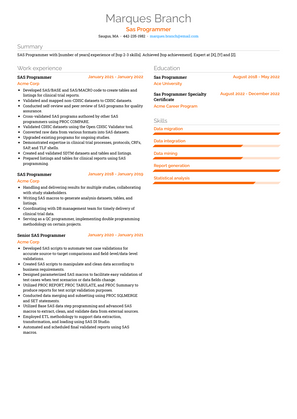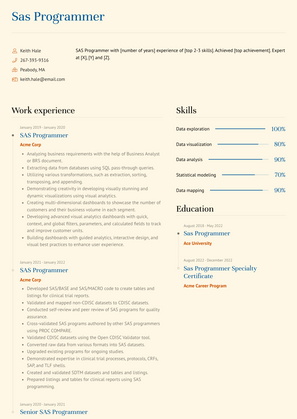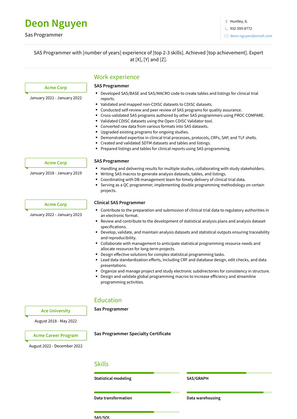Sas Programmer Resume Examples and Templates
This page provides you with Sas Programmer resume samples to use to create your own resume with our easy-to-use resume builder. Below you'll find our how-to section that will guide you through each section of a Sas Programmer resume.



SAS (Statistical Analysis System) is a powerful tool for data analysis, statistical modeling, and business intelligence. As a SAS Programmer, you are responsible for developing and optimizing SAS programs to manipulate, analyze, and report on complex datasets. Your role is crucial in industries such as healthcare, finance, pharmaceuticals, and marketing, where data-driven insights drive decision-making.
A strong SAS Programmer resume should highlight expertise in SAS Base, SAS Macros, SQL, data manipulation, and statistical analysis. Whether you are working with clinical trial data, financial risk models, or large-scale business intelligence reporting, your resume should showcase your ability to clean, process, and analyze data efficiently.
How to Write a SAS Programmer Resume?
A well-crafted SAS Programmer resume should highlight technical expertise, problem-solving abilities, and industry-specific applications. Follow these key principles:
- Start with a professional summary highlighting SAS programming skills, industry expertise, and key accomplishments
- List proficiency in SAS Base, SAS Macros, SQL, data manipulation, and reporting
- Highlight hands-on experience in data extraction, transformation, and statistical modeling using SAS procedures
- Emphasize experience in data validation, automation, and optimization for reporting and analytics
- Quantify impact, for example, "Optimized SAS reporting scripts, reducing processing time by 30%"
How Do I Write a SAS Programmer Resume with No Experience?
If you are new to SAS programming, your resume should focus on training, hands-on projects, and relevant coursework. Here’s how to position yourself effectively:
- Highlight SAS certifications such as SAS Certified Specialist - Base Programming Using SAS 9.4
- Showcase knowledge of SAS procedures (PROC SQL, PROC REPORT, PROC MEANS, PROC FREQ, PROC LOGISTIC, etc.)
- Demonstrate hands-on experience with data manipulation, cleaning, and reporting using SAS
- Include personal projects or coursework where you used SAS for statistical modeling or data visualization
- If transitioning from another field, emphasize transferable skills in data analysis, SQL, Excel, or statistical modeling
How to Write a SAS Resume for 2 Years of Experience?
With two years of experience, your SAS resume should emphasize real-world project execution, problem-solving, and process automation. Key areas to highlight:
- Hands-on experience in SAS Base and SAS Macros for automating data processing workflows
- Proficiency in SQL for data extraction, transformation, and analysis in relational databases
- Experience using SAS procedures (PROC MEANS, PROC FREQ, PROC REPORT, PROC SQL, PROC LOGISTIC)
- Involvement in clinical trial data analysis, financial risk modeling, or customer analytics
- Knowledge of data validation techniques, data cleaning, and data integrity checks
- Quantify impact, for example, "Developed SAS scripts that reduced manual reporting time by 40%"
How to Write a SAS Programmer Resume?
To write a professional SAS Programmer resume, follow these steps:
- Select the right SAS Programmer resume template.
- Write a professional summary at the top explaining your SAS Programmer’s experience and achievements.
- Follow the STAR method while writing your SAS Programmer resume’s work experience. Show what you were responsible for and what you achieved as a SAS Programmer.
- List your top SAS Programmer skills in a separate skills section.
How to Write Your SAS Programmer Resume Header?
Write the perfect SAS Programmer resume header by:
- Adding your full name at the top of the header.
- Add a photo to your resume if you are applying for jobs outside of the US. For applying to jobs within the US, avoid adding photo to your resume header.
- Add your current SAS Programmer to the header to show relevance.
- Add your current city, your phone number and a professional email address.
- Finally, add a link to your portfolio to the SAS Programmer resume header. If there’s no portfolio link to add, consider adding a link to your LinkedIn profile instead.
Bad SAS Programmer Resume Example - Header Section
Eve 7704 Clay St. Huntley, IL 60142 Marital Status: Married, email: cooldude2022@gmail.com
Good SAS Programmer Resume Example - Header Section
Eve Beltran, Huntley, IL, Phone number: +1-555-555-5555, Link: linkedin/in/johndoe
Make sure to add a professional looking email address while writing your resume header. Let’s assume your name is John Doe - here is a formula you can use to create email addresses:
- firstnamelastname@email.com - johndoe@email.com
- firstname.lastname@email.com - john.doe@email.com
- lastname.firstname@email.com - doe.john@email.com
- f.lastname@email.com - j.doe@email.com
- l.firstname@email.com - d.john@email.com
- firstnamelastname12@email.com - johndoe12@email.com
For a SAS Programmer email, we recommend you either go with a custom domain name (john@johndoe.com) or select a very reputed email provider (Gmail or Outlook).
How to Write a Professional SAS Programmer Resume Summary?
Use this template to write the best SAS Programmer resume summary: SAS Programmer with [number of years] experience of [top 2-3 skills]. Achieved [top achievement]. Expert at [X], [Y] and [Z].
Example Summary for a Clinical SAS Programmer Resume
Experienced SAS Programmer with expertise in SDTM migration programming and analysis dataset development. Skilled in translating analysis dataset specifications into SAS code to generate tables, listings, and figures outputs. Proven ability to follow standardized programming procedures to ensure quality and SDTM-compliant datasets and Define_XML documents. Capable of developing analysis datasets specifications based on study analysis algorithms and statistical analysis plans.
SAS Programmer Resume Summary Example
10+ Years experienced Senior SAS Programmer with expertise in automating test case validations and manipulating data using SAS scripts. Skilled in developing parameterized SAS macros to enable efficient validation of test cases. Proficient in producing accurate source-to-target comparisons and field-level/data-level validations. Highly organized and detail-oriented, with a proven track record of delivering high-quality results within strict timelines.
How to Write a SAS Programmer Resume Experience Section?
Here’s how you can write a job winning SAS Programmer resume experience section:
- Write your SAS Programmer work experience in a reverse chronological order.
- Use bullets instead of paragraphs to explain your SAS Programmer work experience.
- While describing your work experience focus on highlighting what you did and the impact you made (you can use numbers to describe your success as a SAS Programmer).
- Use action verbs in your bullet points.
Clinical SAS Programmer Resume Example
Clinical SAS Programmer
- Implement data standards (e.g., CDISC SDTM) in assessment, design, and implementation projects.
- Annotate CRFs according to CDISC Implementation Guideline for migration to SDTM.
- Create SDTM specifications document based on CDISC Implementation Guideline.
- Follow standardized SDTM migration programming procedures to create quality, SDTM-compliant SAS datasets and Define_XML documents.
- Develop analysis datasets (e.g., ADAM) specifications based on SAP or any study analysis algorithm.
- Translate analysis datasets specifications into SAS code to generate datasets and outputs for Tables, Listings, and Figures.
- Troubleshoot and debug SAS code to identify and resolve errors, and maintain documentation of changes made to SAS code, programs, and specifications.
- Modify and maintain SAS programs written by others and coordinate with other programmers about program revisions.
- Ensure QC of SAS programs for datasets, Tables, Listings, and Figures in accordance with departmental QC procedures.
- Apply CDISC standards knowledge (SDTM and ADaM) to dataset programming. Create statistical analysis outputs to support final reports, abstracts, posters, manuscripts, and other clinical publications.
Clinical SAS Programmer Resume Example
Clinical SAS Programmer
- Contribute to the preparation and submission of clinical trial data to regulatory authorities in an electronic format.
- Review and contribute to the development of statistical analysis plans and analysis dataset specifications.
- Develop, validate, and maintain analysis datasets and statistical outputs ensuring traceability and reproducibility.
- Collaborate with management to anticipate statistical programming resource needs and allocate resources for long-term projects.
- Design effective solutions for complex statistical programming tasks.
- Lead data standardization efforts, including CRF and database design, edit checks, and data presentations.
- Organize and manage project and study electronic subdirectories for consistency in structure.
- Design and validate global programming macros to increase efficiency and streamline programming activities.
SAS Programmer Resume Example
SAS Programmer
- Developed SAS/BASE and SAS/MACRO code to create tables and listings for clinical trial reports.
- Validated and mapped non-CDISC datasets to CDISC datasets.
- Conducted self-review and peer review of SAS programs for quality assurance.
- Cross-validated SAS programs authored by other SAS programmers using PROC COMPARE.
- Validated CDISC datasets using the Open CDISC Validator tool.
- Converted raw data from various formats into SAS datasets.
- Upgraded existing programs for ongoing studies.
- Demonstrated expertise in clinical trial processes, protocols, CRFs, SAP, and TLF shells.
- Created and validated SDTM datasets and tables and listings.
- Prepared listings and tables for clinical reports using SAS programming.
Senior SAS Programmer Resume Example
Senior SAS Programmer
- Developed SAS scripts to automate test case validations for accurate source-to-target comparisons and field-level/data-level validations.
- Created SAS scripts to manipulate and clean data according to business requirements.
- Designed parameterized SAS macros to facilitate easy validation of test cases when test scenarios or data fields change.
- Utilized PROC REPORT, PROC TABULATE, and PROC Summary to produce reports for test script validation purposes.
- Conducted data merging and subsetting using PROC SQLMERGE and SET statements.
- Utilized Base SAS data step programming and advanced SAS macros to extract, clean, and validate data from external sources.
- Employed ETL methodology to support data extraction, transformation, and loading using SAS DI Studio.
- Automated and scheduled final validated reports using SAS macros.
SAS Programmer Resume Example
SAS Programmer
- Analyzing business requirements with the help of Business Analyst or BRS document.
- Extracting data from databases using SQL pass-through queries.
- Utilizing various transformations, such as extraction, sorting, transposing, and appending.
- Demonstrating creativity in developing visually stunning and dynamic visualizations using visual analytics.
- Creating multi-dimensional dashboards to showcase the number of customers and their business volume in each segment.
- Developing advanced visual analytics dashboards with quick, context, and global filters, parameters, and calculated fields to track and improve customer units.
- Building dashboards with guided analytics, interactive design, and visual best practices to enhance user experience.
SAS Programmer Resume Example
SAS Programmer
- Handling and delivering results for multiple studies, collaborating with study stakeholders.
- Writing SAS macros to generate analysis datasets, tables, and listings. Safety and efficacy analysis and creation of corresponding TLFs.
- Coordinating with DB management team for timely delivery of clinical trial data.
- Serving as a QC programmer, implementing double programming methodology on certain projects.
Top SAS Programmer Resume Certifications
- SAS Certified Base Programmer for SAS 9
- SAS Certified Advanced Programmer for SAS 9
- SAS Certified Clinical Trials Programmer Using SAS 9
- SAS Certified Data Integration Developer for SAS 9
- SAS Certified Predictive Modeler Using SAS Enterprise Miner 14
- SAS Certified Specialist: Machine Learning Using SAS Viya 3.4
- SAS Certified Specialist: Base Programming Using SAS 9.4
- SAS Certified Visual Modeler Using SAS Visual Statistics 7.4
- SAS Certified Deployment Specialist for Visual Analytics 7.4
Top SAS Programmer Resume Skills for 2023
- Data manipulation
- Data analysis
- Data visualization
- Database access
- Report generation
- Statistical analysis
- Data management
- Data transformation
- Querying
- Statistical modeling
- Data exploration
- Data cleaning
- Data mining
- Data warehousing
- Data quality
- Data integration
- Data validation
- Data modeling
- Data migration
- Data mapping
- Data profiling
- Data loading
- Data architecture
- SAS macro
- SAS/SQL
- SAS/GRAPH
- SAS/ACCESS
- SAS/STAT
- SAS/ETS
Top 10 Certifications for a SAS Programmer Resume
Earning SAS certifications can validate your expertise and make your resume stand out. Consider obtaining:
- SAS Certified Specialist - Base Programming Using SAS 9.4
- SAS Certified Professional - Advanced Programming Using SAS 9.4
- SAS Certified Clinical Trials Programmer
- SAS Certified Big Data Professional
- SAS Certified Data Scientist
- SAS Certified Predictive Modeler
- SAS Certified Business Analyst
- SAS Certified Visual Business Analyst
- SQL Certification (e.g., Oracle, Microsoft) for data extraction and manipulation
- AWS Certified Data Analytics for cloud-based data processing
How Long Should My SAS Programmer Resume Be?
Your resume length should depend on your experience level:
- Entry-level (0-2 years): 1 page, focusing on training, certifications, and hands-on projects
- Mid-level (3-7 years): 1-2 pages, emphasizing industry-specific SAS applications, automation, and optimization
- Senior-level (8+ years): 2 pages, showcasing leadership, advanced analytics, and SAS programming at scale
- Career transition resume: 1-2 pages, highlighting data analysis experience and SAS training
ChatGPT Prompts for a SAS Programmer Resume
Use AI to refine your resume, optimize content, and improve job applications:
- Generate a SAS Programmer resume for 2+ years of experience focusing on data manipulation and statistical analysis
- Create a professional summary for a SAS Programmer specializing in clinical trial data and regulatory reporting
- Write a bullet-point list of SAS Programmer achievements, focusing on automation and process optimization
- Optimize my SAS resume to highlight experience with SQL, SAS Macros, and predictive modeling
- Generate a cover letter for a SAS Programmer applying to a pharmaceutical company
- List key action verbs for a SAS Programmer resume to improve ATS ranking
- Create a resume section highlighting best practices in SAS data processing and statistical analysis
- Suggest keywords to optimize a SAS resume for job applications
- Rewrite my resume’s experience section to emphasize impact and measurable results in SAS programming
- Generate a LinkedIn summary for a SAS Programmer with 2+ years of experience
How can I highlight my experience as a SAS Programmer on my resume?
Focus on your expertise in data analysis, statistical programming, and generating reports using SAS software. Highlight your role in developing SAS programs for data manipulation, analysis, and reporting, especially in clinical trials, financial analysis, or research projects.
What are the key skills to feature on a SAS Programmer's resume?
Emphasize skills in SAS programming, data analysis, statistical modeling, and proficiency with SAS tools such as SAS Base, SAS Macro, and SAS/STAT. Highlight your ability to manage large datasets, automate processes, and create detailed reports.
How do I demonstrate my ability to write SAS programs on my resume?
Provide examples of complex SAS programs you’ve written for data cleaning, analysis, and reporting. Highlight your role in automating data processes, generating insights, and ensuring data accuracy in your analyses.
Should I include metrics on my SAS Programmer resume? If so, what kind?
Yes, include metrics such as the size of datasets managed, improvements in data processing speed, or the accuracy of reports generated. These figures help quantify your impact on data-driven decision-making processes.
How can I showcase my experience with clinical trial data on my resume?
Detail your role in writing SAS programs for clinical trial data analysis, including data cleaning, statistical analysis, and generating Clinical Study Reports (CSRs). Highlight your ability to follow regulatory standards and guidelines, such as CDISC or FDA compliance.
What kind of achievements should I highlight as a SAS Programmer?
Highlight achievements such as optimizing data processing workflows, reducing analysis time, or being recognized for the accuracy and efficiency of your SAS programming. Mention any contributions to successful project completions or regulatory submissions.
How do I address a lack of experience in a specific area of SAS programming on my resume?
Emphasize your core SAS programming skills, attention to detail, and problem-solving abilities. Highlight any relevant coursework, certifications, or projects that demonstrate your readiness to take on more complex SAS programming tasks.
How important is collaboration for a SAS Programmer role?
Collaboration is crucial for working with data analysts, statisticians, and project teams. Highlight your experience in working closely with cross-functional teams to ensure that SAS programs meet project objectives and data accuracy requirements.
How do I demonstrate my ability to automate processes with SAS on my resume?
Mention specific examples where you automated data extraction, transformation, or reporting tasks using SAS macros or scripts. Highlight your ability to streamline workflows and improve efficiency in data processing and reporting.
Should I include certifications on my SAS Programmer resume?
Yes, include relevant certifications such as SAS Certified Base Programmer or SAS Certified Advanced Programmer. These certifications demonstrate your proficiency in SAS and your commitment to maintaining high standards in statistical programming.
-
How can I highlight my experience as a SAS Programmer on my resume?
-
What are the key skills to feature on a SAS Programmer's resume?
-
How do I demonstrate my ability to write SAS programs on my resume?
-
Should I include metrics on my SAS Programmer resume? If so, what kind?
-
How can I showcase my experience with clinical trial data on my resume?
-
What kind of achievements should I highlight as a SAS Programmer?
-
How do I address a lack of experience in a specific area of SAS programming on my resume?
-
How do I demonstrate my ability to automate processes with SAS on my resume?
-
Should I include certifications on my SAS Programmer resume?
Copyright ©2025 Workstory Inc.
